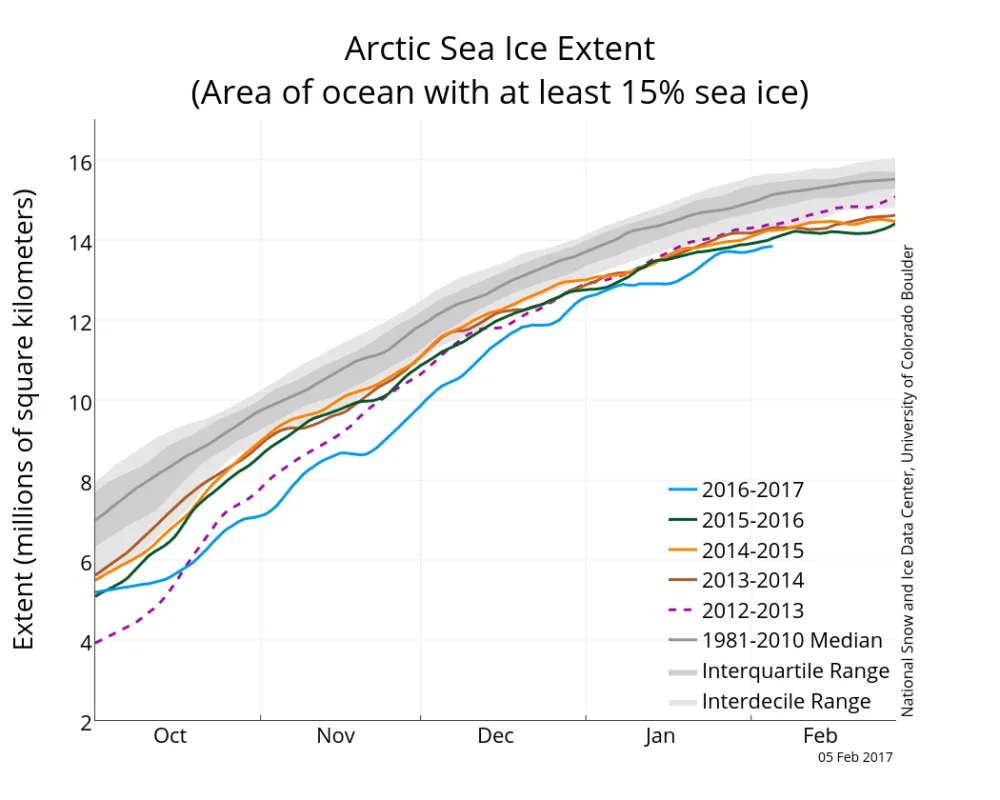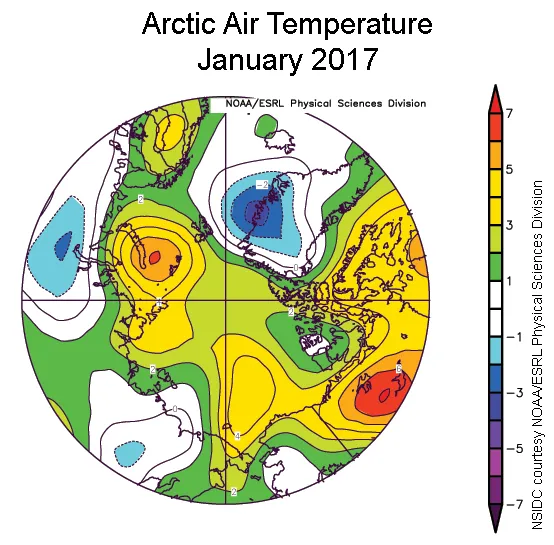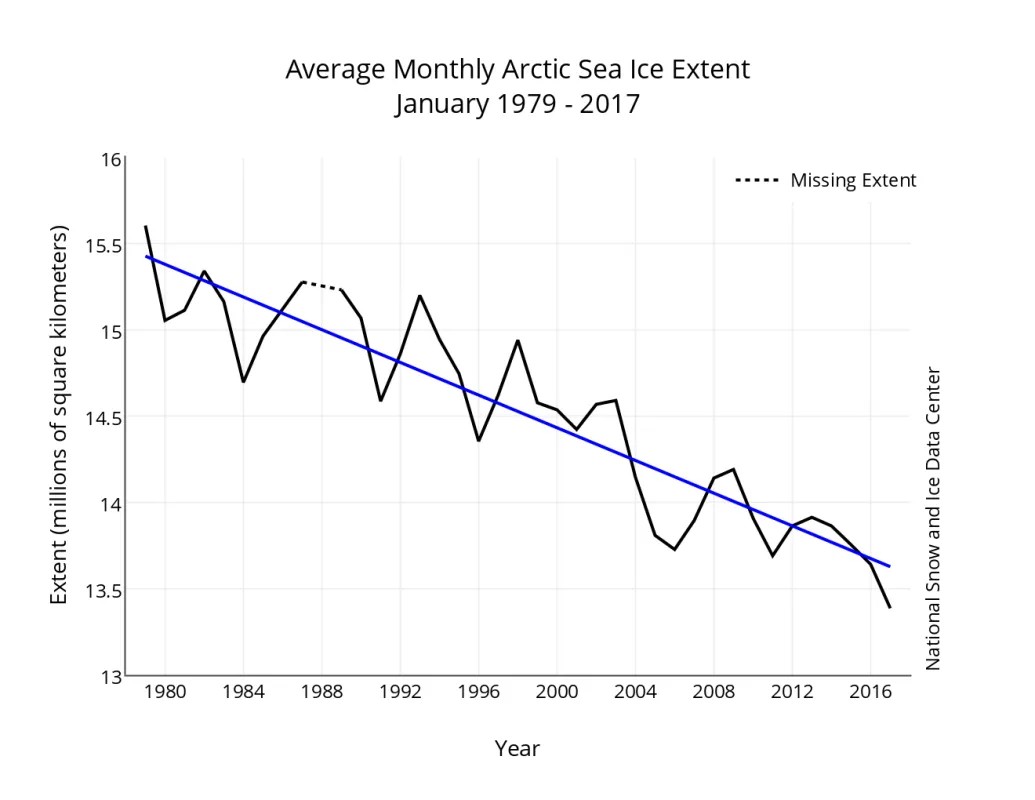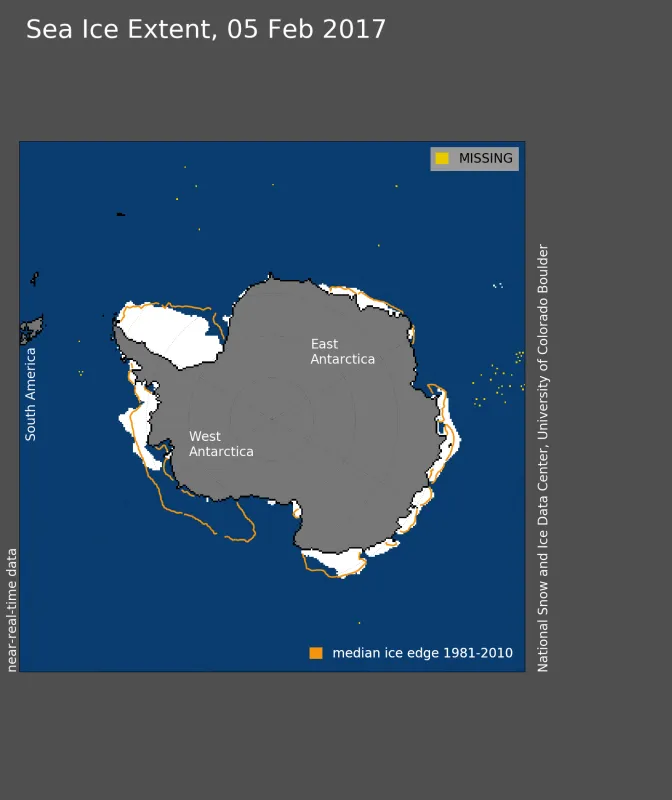Record low daily Arctic ice extents continued through most of January 2017, a pattern that started last October. Extent during late January remained low in the Kara, Barents and Bering Seas. Southern Hemisphere extent also tracked at record low levels for January; globally, sea ice cover remains at record low levels.
Overview of conditions
Arctic sea ice extent for January 2017 averaged 13.38 million square kilometers (5.17 million square miles), the lowest January extent in the 38-year satellite record. This is 260,000 square kilometers (100,000 square miles) below January 2016, the previous lowest January extent, and 1.26 million square kilometers (487,000 square miles) below the January 1981 to 2010 long-term average.
Ice growth stalled during the second week of the month, and the ice edge retreated within the Kara and Barents Seas, and within the Sea of Okhotsk. After January 16, extent increased at a more rapid pace, but the rate of ice growth was still below average for January as a whole. For a few days towards the end of the month, the extent was slightly greater than recorded in 2006, a year which also saw many record low days in January, but by the 30th it was tracking below 2006. Through most of January the ice edge remained north of the Svalbard Archipelago, largely due to the inflow of warm Atlantic water along the western part of the archipelago. However, by the end of January, some ice was found to the northeast and northwest of Svalbard. At the end of January, ice extent remained well below average within the Kara, Barents, and Bering Seas.
Conditions in context
January air temperatures at the 925 hPa level (approximately 2,500 feet above sea level) were above average over nearly all of the Arctic Ocean, continuing the pattern that started last autumn (Figure 2b). Air temperatures were more than 5 degrees Celsius (9 degrees Fahrenheit) above the 1981 to 2010 average over the northern Barents Sea and as much as 4 degrees Celsius (7 degrees Fahrenheit) above average in the northern Chukchi and East Siberian Seas. It was also unusually warm over northwestern Canada. Cooler than average conditions (up to 3 degrees Celsius, or 5 degrees Fahrenheit below average) prevailed over the northwest part of Russia and the northeast coast of Greenland.
Atmospheric circulation over the Arctic during the first three weeks of January was characterized by a broad area of below average sea level pressure extending over almost the entire Arctic Ocean. Higher-than-average sea level pressure dominated over the Gulf of Alaska and the North Atlantic Ocean south of Iceland. This set up warm southerly winds from both the northern North Atlantic and the Bering Strait areas, helping to explain the high January air temperatures over the Arctic Ocean. According to the analysis of NASA scientist Richard Cullather, the winter of 2015 to 2016 was the warmest ever recorded in the Arctic in the satellite data record. Whether the winter of 2016 to 2017 will end up warmer remains to be seen; conditions are typically highly variable. For example, during the last week of January, the area of low pressure shifted towards the Siberian side of the Arctic. In the northern Laptev Sea, pressures fell to more than 20 hPa below the 1981 to 2010 average. This was associated with a shift towards cooler conditions over the Arctic Ocean, which may explain why ice extent towards the end of the month rose above levels recorded in 2006.
January 2017 compared to previous years
Through 2017, the linear rate of decline for January is 47,400 square kilometers (18,300 square miles) per year, or 3.2 percent per decade.
Amundsen Sea nearly free of ice
Extent is tracking at records low levels in the Southern Hemisphere, where it is currently summer. As shown in this plot for February 5, this is primarily due to low ice extent within the Amundsen Sea, where only a few scattered patches of ice remain. By contrast, extent in the Weddell Sea is now only slightly below average. This pattern is consistent with persistent above average air temperatures off western Antarctica.
Further reading
Cullather, R. I., Y.-K. Lim, L. N. Boisvert, L. Brucker, J. N. Lee, and S. M. J. Nowicki. 2016. Analysis of the warmest Arctic winter, 2015-2016. Geophysical Research Letters,43, doi:10.1002/2016GL071228.




